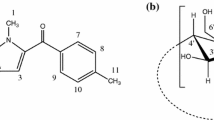Abstract
The interaction of tricyclazole (TCZ) with β-cyclodextrin (β-CD) and human serum albumin (HSA) were studied by fluorescence spectrum, UV-visible spectrum and second-order scattering technology. It was shown that TCZ has quite a strong ability to quench the fluorescence launching from HSA by reacting with it and forming a certain kind of new compound. The quenching and the energy transfer mechanisms were discussed, respectively. The binding constants and thermodynamic parameters at four different temperatures, the binding locality, and the binding power were obtained. The conformation of HSA was discussed by synchronous and three-dimensional fluorescence techniques. The inclusion reaction between β-CD and TCZ was explored by scattering method, the inclusion constants and the thermodynamic parameters at 297 K and 311 K were figured out, respectively. The mechanism of inclusion reaction was speculated and linkage among the toxicity of TCZ, the exterior environment and its concentration was attempted to explain on molecule level.










Similar content being viewed by others
References
Kragh-Hansen U (1990) Structure and ligand binding properties of human serum albumin. Dan. Med. Bull. 37:57–84
Cheger SI (1975) Transport Function of Serum Albumin, Buharest, p. 178
Sudlow G, Birkett DJ, Wade DN (1975) The characterization of two specific drug binding sites on human serum albumin. Mol. Pharmacol 11:824–832
Haque SJ, Poddar MK (1984) Interactions of cannabinoids with bovine serum albumin. Biosci. Rep 4(3):239–243
Purohit G, Sakthivel Th, Florence AT (2003) The interaction of cationic dendrons with albumin and their diffusion through cellulose membranes. Int. J. Pharm 254:37–41
Borga O, Borga B (1997) Serum protein binding of nonsteroidal anti-inflammatory drugs: A comparative study. J. Pharmacokinet. Biopharm 25:63–77
Angelakou A, Valsami G, Macheras P, Koupparis M (1999) A displacement approach for competitive drug-protein binding studies using the potentiometric -anilino-8-naphthalene-sulfonate probe technique. Eur. J. Pharm. Sci 2:123–130
Romanini D, Avalle G, Farruggia B, Nerli B, Pico G (1998) Spectroscopy features of the binding of polyene antibiotics to human serum albumin. Chem. Biol. Interact 115(3):247–260
Rosso SB, Gonzalez M, Bagatolli LA, Duffard RO, Fidelio GD (1998). Evidence of a strong interaction of 2,4-dichlorophenoxyacetic acid herbicide with human serum albumin. Life Sci 63(26):2343–2351
Scatchard G (1949) The attractions of proteins for small molecules and ions Ann. NY Acad. Sci 51:660–672
Szejtli J (1988) Cyclodextrine Technology. Kluwer Academic Publishers, Dodrecht, The Netherlands, pp. 143–154
Harada A (2001) Cyclodextrin-based molecular machines. Acc Chem Res 34(6):456–464
Ikeda H, Nakamura M, Ise N (1996) Fluorescent cyclodextrins for molecule sensing: fluorescent properties, NMR characterization and inclusion phenomena of N-dansylleucine-modified cyclodextrins. J. Am. Chem. Soc 118:10980–10988
Szejtli J, Sebesty Gén (1979). Resorption, metabolism and toxicity studies on the peroral application of beta-cyclodextin. Starch 31:385–389
Partanen R, Ahro M, Hakala M, Kallio H, Forssell P (2002) Microencapsulation of caraway extract in β-cyclodextrin and modified starches. Eur Food Res Technol 214:242–247
Cai WS, Yu YM, Shao XG (2005) Chiral recognition of aromatic compounds by β-cyclodextrin based on bimodal complexation. J. Mol. Model 11:186–193
Manabe M, Ochi T, Kawamura H, Katsu-ura H, Shiomi M, Bakshi MS (2005) Volumetric study on the inclusion complex formation of α- and β-cyclodextrin with 1-alkanols at different temperatures. Colloid Polym Sci 283:738– 746
JR Lakowicz (1999). Principle of Fluorescence Spectroscopy 2nd Ed. Plemum Press, 13
Yan CN, Zhang HX, Liu Y, Mei P, Li KH, Tong JQ (2005) Fluorescence spectra of the binding reaction between paraquat and bovine serum albumin. Acta chim. Sinica 63:1727– 1732
Yan CN, Zhang HX, Liu Y, Mei P (2005) Study on binding reaction between flucytosine and bovine serum albumin. Chin. J. chem 23:1151–1156
Stryer L (1968) Fluorescence spectroscopy of proteins. Science 162(853):526–533
Vaughan WM, Weber G (1970) Oxygen quenching of pyrenebutyric acid fluorescence in water: a dynamic probe of the microenvironment. Biochemistry 9:464–473
Ross DP, Subramanian S (1981) Thermodynamics of protein association reactions: forces contributing to stability. Biochemistry 20:3096–3102
Luo HQ, Liu SP, Li NB (2003). New methods for the determination of the inclusion constant between procaine hydrochloride and β-cyclodextrin by resonance nonlinear scattering technology. Acta chim. Sinica 61(3):435–439
Muthu Vijayan Enoch IV, Swaminathan M (2004) Inclusion complexation of 2-amino-7-bromofluorene by β-Cyclodextrin: spectra characteristics and the effect of pH. J. Fluorescence 14:751– 756
Acknowledgements
We gratefully acknowledge financial support of Anton Scholarship provided by Beijing Antonoil Engineering & Technology Co., Ltd.
Author information
Authors and Affiliations
Corresponding author
Rights and permissions
About this article
Cite this article
Zhang, HX., Huang, X., Mei, P. et al. Studies on the Interaction of Tricyclazole with β-cyclodextrin and human Serum Albumin by Spectroscopy. J Fluoresc 16, 287–294 (2006). https://doi.org/10.1007/s10895-006-0087-7
Received:
Accepted:
Published:
Issue Date:
DOI: https://doi.org/10.1007/s10895-006-0087-7




